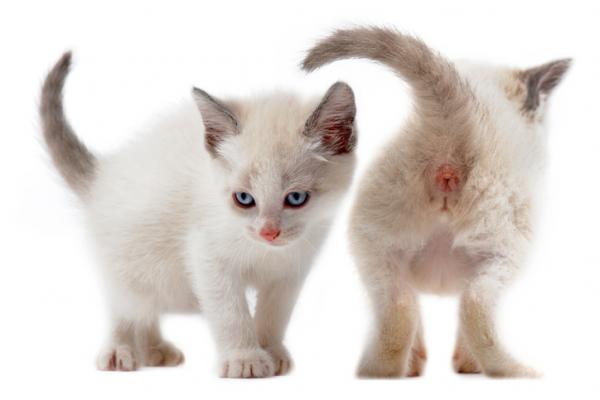Perianal fistula in cats – Treatment and care

The perianal fistulas they are paths that originate in some internal location of the body of the animal, such as the anal glands, and flow into the skin, just in the area near the anus.
Although they are not as frequent as in dogs, perianal fistulas in cats they are equally unpleasant and painful, and require a treatment and special care that we will review in this article.
Causes of perianal fistulas in cats
In dogs, especially in some breeds such as the German Shepherd, the immune system is usually involved more often than in cats, while in felines, in which these fistulas are already uncommon, the problem is usually in the glands or anal sacs. These glands are located on both sides of the anus of the animal and release a substance that, in addition to functioning as a lubricant, helping the exit of feces, has a characteristic smell that serves to recognize each other.
Neither dogs nor cats are capable of voluntarily emptying these glands, which on the other hand, lack an autonomous emptying, since this is produced by the pressure exerted by the faeces on leaving. For this reason, in some animals in which the exit of the feces is not as regular as it should be, that is, in the cases of constipation or diarrhea, the emptying of the glands is not done effectively, being able to cause a cumulus of fluid inside it capable of causing a fistula or infection of the anal glands in cats.
Obstructions in the drainage duct These bags are also capable of causing this problem, at least in theory. In addition, the anal sacs can suffer an infection, which can lead to a fistula or an abscess, which, in turn, can also fistulize.
Symptoms of perianal fistulas in cats
Cats that suffer from this problem will Lick frequently the area of the anus, this being the most indicative symptom. On the other hand, and although it is paradoxical, anal fistulas in cats are sometimes accompanied by constipation, and in others, diarrhea. So both conditions can be warning factors to go to the veterinarian.
In any case, a fairly constant symptom is the difficulty defecating because of the pain the animal feels. Likewise, small traces of blood can be found in the cat’s feces, so it will be essential to check his stools if we have noticed the previous symptoms.
Treatment and care of perianal fistula in cats
As with most health problems, treatment should always be focused on the cause that causes it. In this way, visit the veterinarian to review the anal fistulas in the cat and determine the underlying reason, it will be mandatory to set the steps to follow.
If the immune system is responsible.
The result is usually good use of drugs such as cyclosporine, tacrolimus or corticosteroids, the latter with very good efficacy but with long-term side effects that must be considered. These drugs are administered orally and their effectiveness increases if they are supplemented by applying an ointment in the affected area that also includes them in its composition. Anyway, since they cause a lowering of the defenses, mainly corticoids, and this is something quite undesirable in an area so populated with bacteria such as the anus and its vicinity, it is advisable to use an ointment that also includes antibiotics .
A great option are the compounds that are marketed for the treatment of otitis in dogs and cats, since most incorporate corticoids and antibiotics and many have a creamy texture, which makes them very easy to apply.
Pathologies of the anal sacs
In cats, as we have been commenting throughout the article, the problems of the immune system are not so common, so the pathologies of anal sacs are usually more frequent. For this reason, the oral drugs mentioned above are usually not necessary or effective for these cases, with the exception of antibiotics, although the application of a ointment with corticoids It usually gives good results, since it serves to control inflammation. And as in the previous case, it is recommended that this ointment also contain antibiotics.
In the cases of pathologies of the anal sacs that do not improve with the treatment or that return to appear once finalized this, a surgical extirpation of the glands may be necessary.
Emptying the anal glands and maintenance
Whether or not the anal glands are involved, it is worthwhile to empty them. These glands are found on both sides of the anus of the animal, approximately in the area that would correspond to the 4 and 8 hours in a clock.
Although the origin of the problem is not in the anal glands, in a cat that has suffered a fistula in this place, it is convenient to control the area periodically and empty the anal glands regularly. This article explains how to empty the anal glands in cats.
Finally, do not forget that, whatever the cause of the fistula, it is advised clean the area with an antiseptic product, such as chlorhexidine or betadine diluted in water in proportion of 1 to 3. In addition, antibiotics should always be given to treat infection of the cat’s anal glands, if any, or to prevent it. Metronidazole is an antibiotic that has been very effective in these cases.

This article is merely informative, in .com we do not have the faculty to prescribe veterinary treatments or make any kind of diagnosis. We invite you to take your pet to the veterinarian in case of any type of condition or discomfort.
If you want to read more articles similar to Perianal fistula in cats – Treatment and care, we recommend that you enter in our section of Infectious diseases.


